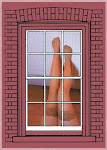
Su sitio web es magnífico www.jant-bi-acogny.com They have a great web site
Germaine Acogny, African born but European trained,(she´s worked with Maurice Bejart and Peter Gabriel, the musician), formed the Jant-Bi Company in 1998. The principal aim is to train dancers from all over Africa in traditional African dances and in European contemporary dance techniques.
According to the programme,Waxtaan is a critical look at African leaders, but for the Spanish people I spoke to afterwards, and for myself, the miming and gestures of musicians and dancers weren´t clear. There wasn´t much "contemporary" work but what there was, was correct... well, technically correct. I would have liked to have seen more defined personalities in the comical pieces, although I don't think it was necessary in the traditional numbers. There was good use of the "African-style" chairs that were always on stage, sometimes to sit on, sometimes as purely decorative items and sometimes as elements in some of the dances. Dancing in European suits and ties, even in the traditional dances, was a nice touch. And the eight boys sure could dance. Accompanied by the percussionists of L'Ecole de Sable, I felt like being up there on the stage with them - only I have the wrong skin-colour and am the wrong gender.
And the best of the night were the three "espontaneos" who jumped onto the stage at different moments of the last piece when each dancer was doing his solo. Later on, I learnt that one of them is an "African dance" teacher and that they were promoting a show they are going to put on. (In Clamores, by the way, the 7 and 11 May)



No hay comentarios:
Publicar un comentario